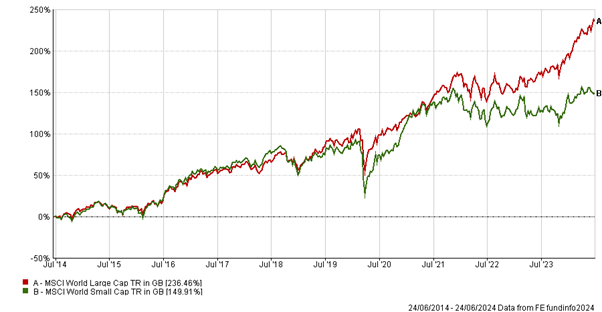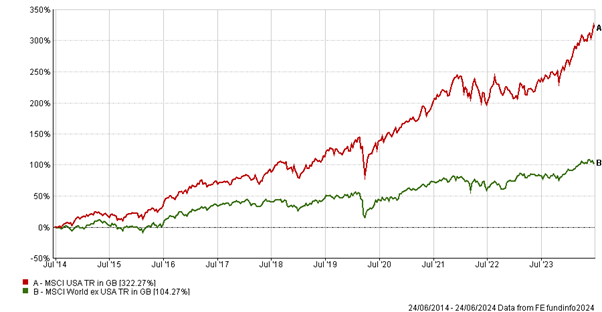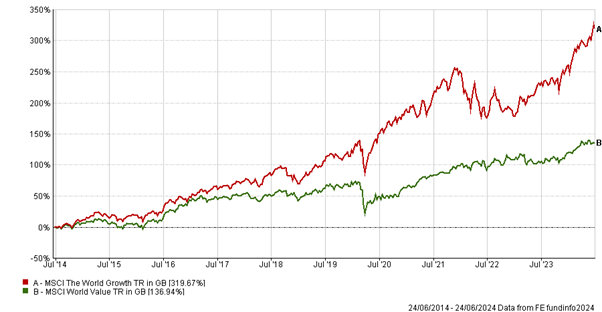
24th May 2024
In last week’s Crescendo, Daniel made a stirring case for the use of active managers and outlined how our fund selection has been a crucial element of our own Fund’s strong performance, helping offset the considerable headwind posed by our long-standing low exposure to US equities. This note highlights quite how powerful that headwind has been, and broadens the conversation to consider how the other biases in our equity selections have impacted performance and what implications past returns and resulting relative valuations might mean for the future.
As regular readers will know, we are style agnostic investors and typically like to blend a range of best in breed managers offering a diversity of investment philosophies and approaches. We do, however, like to invest with valuation on our side, and for some years now, this focus on valuation derived margin of safety has led us to favour small caps over large, non-US markets over the US and (in most regions) value over growth. As the charts below demonstrate, all of these skews have been deeply unhelpful with large caps outperforming small, the US outperforming non-US markets and growth outperforming value (although our ability to dynamically shift the portfolio around and to focus on niche markets has helped mitigate some of these issues).
Small versus Large

Non-US versus US

Value versus Growth

Despite the howling headwinds emanating from this confluence of factors, Vanbrugh is strongly first quartile over 3, 5 and 10 years which in part is to do with our active fund selections outperforming their respective market segments as well as the granular and dynamic portfolio construction alluded to above. Also important is our ability to add value via the use of investment trusts which not only offer exposure to a range of alternative asset classes, but also the opportunity to harvest idiosyncratic returns via engagement and discount trading.
Returning to equity market leadership, it’s important to acknowledge just how extreme the performance bifurcation has been, both in terms of time and the quantum of returns. The outperformance of US large caps over small, for example, is at the most extreme level since November 1999 whilst growth’s trouncing of value is at a level not seen since March 2000. When thinking about this bifurcation, it’s instructive to consider what has driven these respective returns and to ask whether or not it seems plausible that what has worked in the past is likely to continue to lead markets in the future. Have the small-cap and value factors recognised in the original Fama-French stock pricing model permanently ceased to be effective as two of the three key explanatory factors behind stock outperformance? Is persistent US outperformance due to some sort of US exceptionalism?
Decomposing returns to isolate the extent to which relative performance has been driven by fundamental earnings growth versus changes in valuation emphatically suggests this is not the case. A recent study by AQR, for example, shows how the vast majority of the US market outperformance versus the rest of the world over the past decade or so is explained by multiple expansions and not by wildly superior fundamentals, or to put it more simply, by the US becoming more expensive. It’s a similar story when looking at value and growth where the valuation premium commanded by growth stocks is currently at extreme levels relative to history. Looking at the above charts with a deeper understanding of what has driven those relative returns enables a more objective analysis of whether they are likely to be sustainable going forward. Given the mean reverting nature of valuations, we don’t think it’s overly contentious to argue that investors should perhaps be concerned that the probability of equity market leadership remaining the same might be low going forward. The post dot.com bubble experience where large-cap and growth valuations dramatically compressed and small companies and value materially outperformed being a stark case in point.
As to why investors have been willing to bid up and pay exorbitant premiums for large-cap, US growth stocks is well beyond our circle of competence. What history shows though is that valuation eventually matters and that episodes of market leadership tend not to last forever, particularly once performance and valuation differentials hit such extreme levels. The timing of this unwind is impossible to call but we’re pretty sure the elastic band will snap at some point. In the meantime, our active managers will keep doing what they’re doing and keep delivering alpha, but just imagine what might be possible if some of those howling factor headwinds turn into a gentle breeze at our backs.
Ben Mackie – Senior Fund Manager

For professional advisers only. This article is issued by Hawksmoor Fund Managers which is a trading name of Hawksmoor Investment Management (“Hawksmoor”). Hawksmoor is authorised and regulated by the Financial Conduct Authority. Hawksmoor’s registered office is 2nd Floor Stratus House, Emperor Way, Exeter Business Park, Exeter, Devon EX1 3QS. Company Number: 6307442. This document does not constitute an offer or invitation to any person, nor should its content be interpreted as investment or tax advice for which you should consult your financial adviser and/or accountant. The information and opinions it contains have been compiled or arrived at from sources believed to be reliable at the time and are given in good faith, but no representation is made as to their accuracy, completeness or correctness. Any opinion expressed in this document, whether in general or both on the performance of individual securities and in a wider economic context, represents the views of Hawksmoor at the time of preparation and may be subject to change. Past performance is not a guide to future performance. The value of an investment and any income from it can fall as well as rise as a result of market and currency fluctuations. You may not get back the amount you originally invested. FPC24170.
